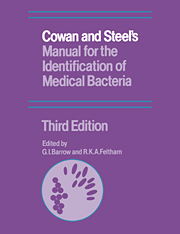Book contents
- Frontmatter
- Contents
- Foreword
- Preface to the first edition
- Postscript
- Preface to the second edition
- Preface to the third edition
- List of contributors
- Introduction
- 1 Classification and nomenclature
- 2 Culture media: constituents and sterilization
- 3 Principles of isolation
- 4 Bacterial characters and characterization
- 5 Theory and practice of bacterial identification
- 6 Characters of Gram-positive bacteria
- 7 Characters of Gram-negative bacteria
- 8 Taxonomy in theory and practice
- 9 Bacterial identification by cards
- 10 Bacterial identification by computer
- 11 Quality control in microbiology
- Appendices
- References
- Index
5 - Theory and practice of bacterial identification
Published online by Cambridge University Press: 15 December 2009
- Frontmatter
- Contents
- Foreword
- Preface to the first edition
- Postscript
- Preface to the second edition
- Preface to the third edition
- List of contributors
- Introduction
- 1 Classification and nomenclature
- 2 Culture media: constituents and sterilization
- 3 Principles of isolation
- 4 Bacterial characters and characterization
- 5 Theory and practice of bacterial identification
- 6 Characters of Gram-positive bacteria
- 7 Characters of Gram-negative bacteria
- 8 Taxonomy in theory and practice
- 9 Bacterial identification by cards
- 10 Bacterial identification by computer
- 11 Quality control in microbiology
- Appendices
- References
- Index
Summary
It goes without saying that adequate clinical information is essential to enable appropriate culture media to be chosen for primary isolation. We believe that the subsequent investigation of the organism(s) thus isolated should be approached with an open mind; the organism(s) should be regarded as unknown and the process of identification started from the basic (primary) characters.
Theory of identification
In theory the identification of a bacterium consists of a comparison of the unknown with the known, the object being the ability to say that the unknown is like A (one of the known bacteria) and unlike B–Z (all other known bacteria); another and arguably equally important objective is to be able to say that the unknown organism is the same as A and thus to give it a name or identification tag. When we say that it is A we imply that it is different from all the other known bacteria, B–Z. All identification schemes depend on knowing a great deal about the already identified (or known) units, but the human memory can cope with only a small proportion of this knowledge, so memory aids are essential. In practice there are at present two distinct methods of making the identification; but the feasibility of a third method using a computer, first suggested by Payne (1963), was demonstrated by Dybowski & Franklin (1968) and is discussed in Chapter 10.
The first method is familiar to all biologists and uses the dichotomous key.
- Type
- Chapter
- Information
- Publisher: Cambridge University PressPrint publication year: 1993
- 1
- Cited by



